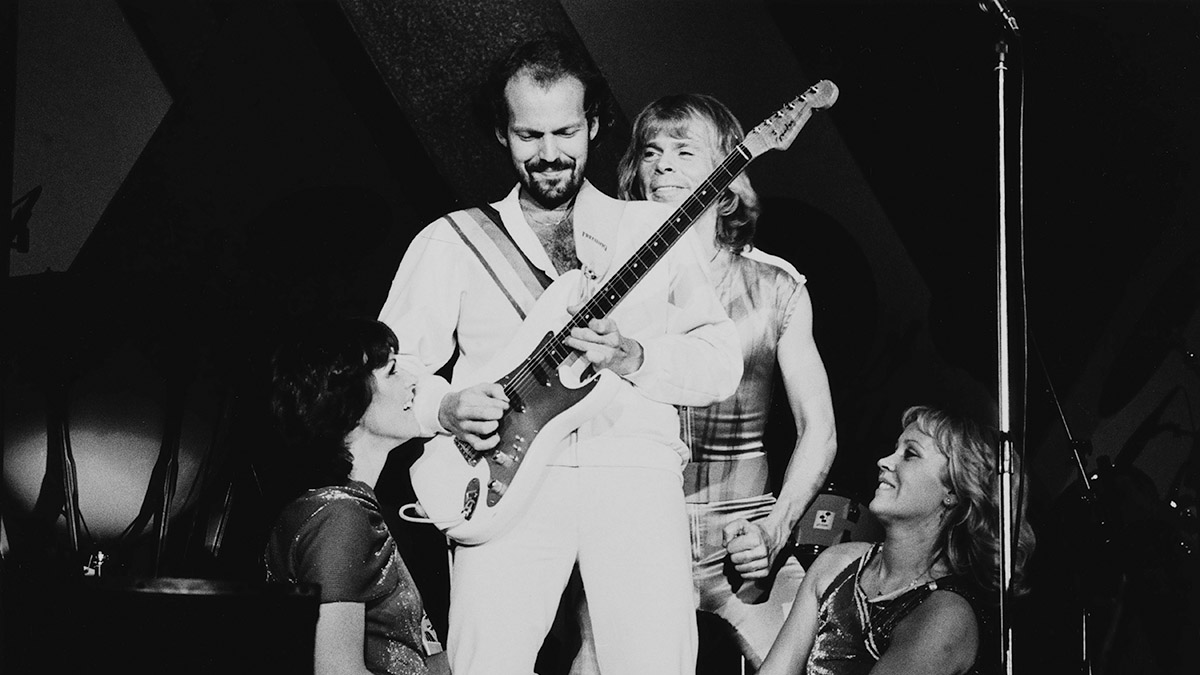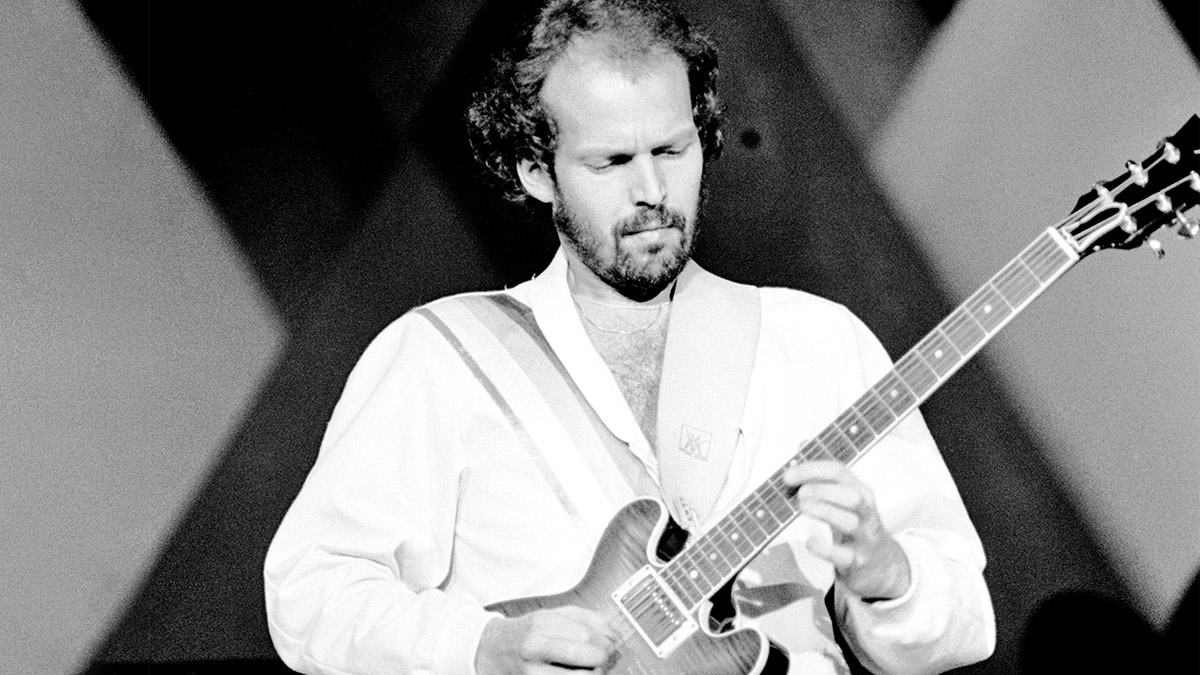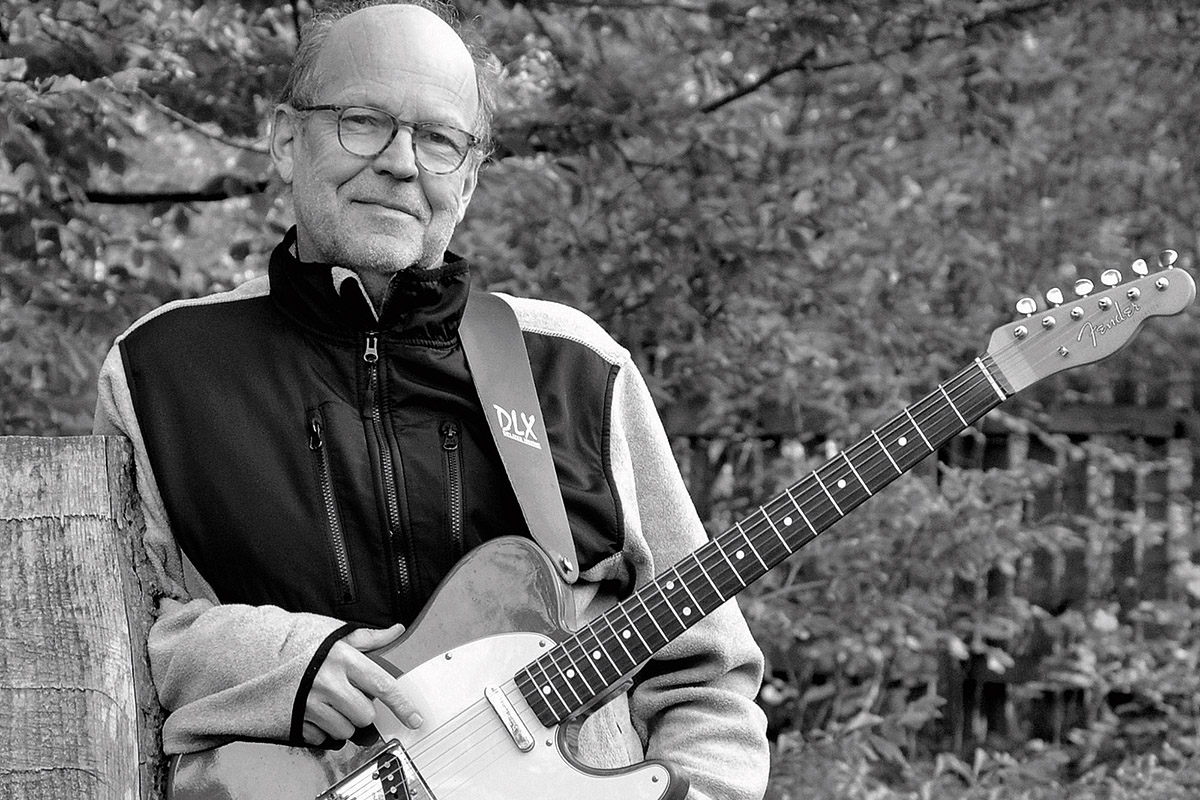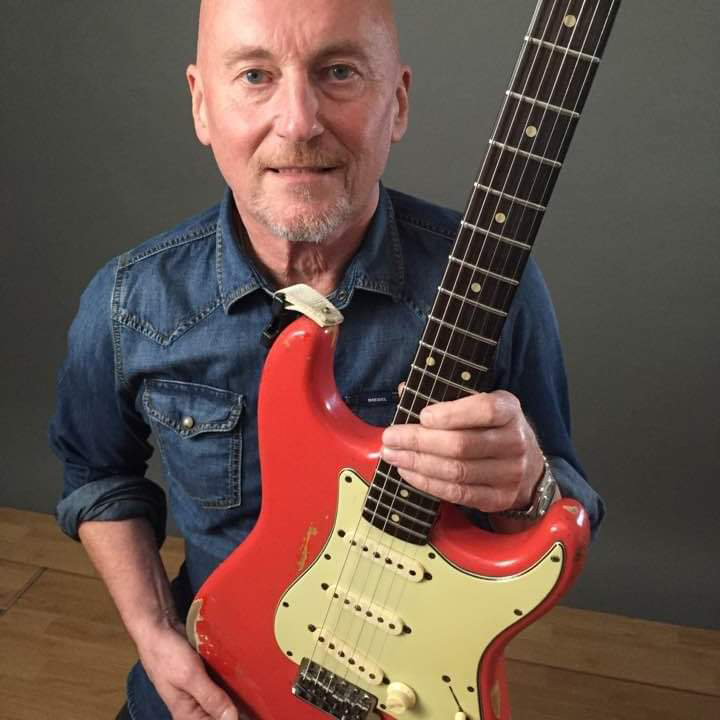ABBA guitarist Lasse Wellander shares his story of playing for the Swedish pop institution
As ABBA’s Voyage tops the charts the world over, we meet the man whose guitar has graced records and stages alongside Agnetha, Björn, Benny and Anni-Frid since the mid-'70s

Benny Andersson and Björn Ulvaeus recruited Lasse Wellander into the ABBA fold very early in the band’s formation. They’d seen him play in both pop and blues-rock situations and knew he’d be great for the job.
Not only did Lasse play on most of the singles and albums, he also trekked the world backing the band on the legendary ‘Abbamania’ tours of Australia and Japan, and an equally unforgettable sold-out run of shows at London’s Wembley Arena.
A softly spoken, self-effacing musician, Lasse almost downplays his role in the creation of so many of those seminal tunes. But listen to almost any ABBA song and you might be surprised at just how many guitar parts there are – and it’s likely Lasse Wellander played some or all of them.
We spoke to Lasse just prior to the release of the latest chart-topping ABBA release, Voyage, on which he was again called to help recreate the sound that has sold over 400 million records… and counting.
What were you doing before you got the call from ABBA?
“I played with a group called Nature from 1970. We were a rock-blues group, but we were asked to accompany a guy called Ted Gärdestad, who was a young star in Sweden. In 1972 he made it really big with a song called Jag Vill Ha En Egen Måne [I Want My Own Moon]. So the band got a call: did we want to back Ted Gärdestad? We said yes, and toured with him in the summers of ’73, ’74 and ’76.
I thought it would be big, quite early on. Strong songs all the way. Even the simple pop numbers were very high quality
“In Sweden we had something called the people’s parks, the folkparks – very big outdoor places in almost every town. The tours went on from the end of April into August, Fridays and Saturdays, at least two gigs, sometimes three. Midsummer’s Eve we did five. That suited us fine because the summers could be quiet, work-wise.
Get The Pick Newsletter
All the latest guitar news, interviews, lessons, reviews, deals and more, direct to your inbox!
“Anyway, Björn and Benny were very involved in Ted’s career, and they had heard our band play in a club in Stockholm called Alexandra’s. They liked what and how we played, even if our own music was very different from Ted’s. I had met Björn and Benny before that, but we were a bit surprised that they asked us. Then they came to a rehearsal sometime in ’74 and asked me if I wanted to do an ABBA session. If I remember rightly it was Intermezzo No 1 [ABBA, 1975], Tiger [Arrival, 1976], and two or three other numbers.”

Did you know any other of the musicians who came to join ABBA, for instance that amazing bass player?
“Yes, Rutger [Gunnarsson]. He was fantastic. I had met him before. Ola Brunkert [drummer], too, and Finn Sjöberg, another guitar player on those songs and also on the 1977 tours. So, yes, I’d met them.”
Was it immediately obvious there was a chemistry that would lead to something very big?
“Yes, I thought it would be big, quite early on. Strong songs all the way. Even the simple pop numbers were very high quality. One of the first tracks I recorded with them was Knowing Me, Knowing You. I think that’s still one of the better songs throughout the years.”
Were you considered a band member? Or was it like Steely Dan where they’d call in different people?
“We were a core of musicians. It wasn’t a full-time job to work with ABBA – and sometimes I couldn’t play, so Janne Schaffer was called in, and the reverse. And if Rutger was on tour doing something else, Mike Watson would play bass. So it wasn’t a full-time job. If you were in the North of Sweden you maybe didn’t go down to Stockholm to do one just track. But I belonged to that core of musicians from ’74 on.”
How common was it for you to have lots of parts on some of the songs?
“Sometimes I doubled the electric guitars, especially rhythm guitars. With acoustic guitar, sometimes maybe two or three of us were playing, often Rutger, me and Björn – he is very good on acoustic guitar.”
Lots of capo use, too…
“Yes, absolutely. I seldom use barre chords. I wanted it to be as open-sounding as possible, so the more open strings the better.”
Did you work with Benny and Björn to come up with your parts?
“Some lines were there already because Benny had written them on the piano, so I did that on guitar. But there was a lot of jamming and spreading of ideas and finding out things. And while I can read [music], there were never charts with ABBA. We wrote the chords down. Neither of the guys can read music in that way. Of course, chords and so on, but not notation. I don’t know nowadays, maybe they’ve trained, but not then.
“In those days, we [recorded entire rhythm tracks together], and then they overdubbed. Maybe Rutger and I would do something again, the second verse or something, but mainly it was a whole track. And I was able to bring my own sounds [to the recording].”
What was the usual setup that you took to the studio?
“Early on, it was a Les Paul ’57 Goldtop and a small Marshall combo. Not very many effects – it was quite a straight sound. They’d put on whatever delay afterwards. But I had a flanger, an Electro-Harmonix Electric Mistress. I loved that.”
Did you bring a lot of different guitars to the sessions?
“It was mainly just one electric guitar, if there weren’t any special requests. Later on, I used a Fender ’62 Strat on most of the songs in the studio and on the tours. But the pickups were very weak and there was more hum than sound sometimes. So I changed all the pickups and switches and everything but, of course, kept the originals.
“Then I changed the bridge pickup to a stacked humbucker because the single coil was weak and there was always trouble with the distorted sound. I also played a Gibson ES-175 on some of the songs. For many years I used a Music Man amp, the small one, the 112HD.
“The Strat is now in the ABBA museum in Stockholm. I wasn’t using it any more. I’ve actually been using a Line 6 James Tyler Variax for some years. The first generation wasn’t a success, really; the idea was very good but the build of the guitar was so-so. Also, the first ones didn’t have the magnetic pickups, it was only the Variax system. This one has both. It’s a great guitar, very stable.”
It was hysterical, just like when The Beatles came to New York or something!
How did you find the tours? Was it like Beatlemania?
“I played on everything from ’75 onwards. And yes, it was. Especially in Australia and Japan. It was hysterical, just like when The Beatles came to New York or something!”
So did you live the life of a rockstar?
“No, we didn’t. It was quite hectic on these tours. In Australia and Japan we had some time off, otherwise it was bus, airport, aeroplane, bus, check-in, soundcheck, concert, hotel.”
How did you recreate your studio sounds on stage? There wasn’t the technology then that we have now.
“I had two Music Man amps with 4x10-inch speakers, an A/B splitter for the distorted sound and the clean, and a pedalboard. On the first tour I had a lot of pedals with short cords in between, and there was always some problem with it. So before the Japan tour we got a proper pedalboard built by Pete Cornish. It wasn’t cheap, but it was worth every penny because it was super quiet.”
On stage, were you allowed to improvise or were you strictly limited to the parts on the records?
“If you listen to the Live At Wembley Arena album, for example, it was much looser than on the records. Of course, we played the things that belonged to the song, but there were parts where it was much looser. It sounded rockier live than on the record, and there were some solos.”
A lot of the songs are in guitar-friendly keys – there’s not too much Bb and Eb, is there?
“When they wrote the song they were sitting with one acoustic guitar and a piano. It suited the girls’ voices, too, which was very important. On songs like Take A Chance, there is so much going on, which was why you needed more than one guitarist on the live gigs.
“On the intro to Gimme! Gimme! Gimme! [where it’s shifting through the arpeggiated chords] it’s actually not doubled: there’s only one [guitar], but it had some effect added to it – maybe a small amount of Electric Mistress, or [producer] Michael B Tretow adding some Eventide Harmonizer. It’s hard to remember what was done 45 to 50 years ago!
“With the Knowing Me, Knowing You track, there’s a melody guitar and a harmony guitar, not doubled, plus two electric powerchord guitars playing the same thing, plus some acoustic guitars. It’s very thought through.”
What were your favourite tracks to play live?
“Well, I liked Eagle because I had a long guitar solo in that song. I enjoyed it all, actually, but I looked forward a bit more to that number. It was amazing being out on the road. We played six days at Wembley Arena, full house.
“One interesting thing about those days at Wembley Arena was, because it was already decided that we should do a tour in Japan, there were a lot of Japanese people there measuring how everything was positioned on stage.
“There was a break before the Japan tour, that was 1981, I think. When we came to rehearse the Japan shows, everything was set up to the millimetre, exactly as we had it on stage. You didn’t have to move anything. Not a guitar stand or anything. Perfection!”

What did you do when ABBA stopped touring and recording? They never announced that they’d split, they just stopped doing it.
“Well, I had always been a freelancer. I was working with a lot of other bands and sessions, TV jobs, nightclubs and theatres, so I just went back to work. I played with four different groups during the 80s.
“Recently, I’ve mostly been recording some of my own songs. I’ve put 14 songs on the streaming platforms since 2017. There’s a Spotify playlist that’s available on my website and one more is coming soon.
“I’ve also been doing overdubs for other people, remote guitar overdubs. At the moment in the pipeline is an English group called Girl Gone Bad, and there’s a Danish hard-rock singer. It’s very different. Sometimes there’s a lot, sometimes there’s less. I’m actually retired now, stage-wise.”
So, now we come to the new ABBA album, Voyage. Was it a surprise when they called you?
“Actually, it started in April 2017. Benny called and said we’re going to do a couple of songs with the old band. We did two: I Still Have Faith In You and Don’t Shut Me Down. So something was going on, but it sounded like these were going to be for the ABBA tour project that they were planning.
“Then spring 2019, Benny called again and we did two more songs. So I suspected something. Then at the beginning of summer last year we did four more. I’d heard that they are bringing in two older songs, too, but we recorded eight new ones.”
In the old days, there was a bit more jamming and trying out. This time it was Benny with his Synclavier. And there’s nothing wrong with that
The sound is still clearly ABBA, but Agnetha and Anni-Frid’s voices have become richer, haven’t they?
“They are a bit deeper, yes. It’s natural, everybody gets lower [as they get older]. They are really good singers, both of them. Before ABBA, they had been singing for many years in different environments – dance bands and all that.”
Were the recording techniques the same this time around?
“There was more pre-production this time. In the old days, there was a bit more jamming and trying out. This time it was Benny with his Synclavier. And there’s nothing wrong with that because that’s how you do it these days.”
- Voyage is out now via Capitol.
In the late '70s and early '80s Neville worked for Selmer/Norlin as one of Gibson's UK guitar repairers, before joining CBS/Fender in the same role. He then moved to the fledgling Guitarist magazine as staff writer, rising to editor in 1986. He remained editor for 14 years before launching and editing Guitar Techniques magazine. Although now semi-retired he still works for both magazines. Neville has been a member of Marty Wilde's 'Wildcats' since 1983, and recorded his own album, The Blues Headlines, in 2019.
“I just learned them from the records. I don’t read tabs or anything, I don’t read music – I learned by ear”: How a teenage Muireann Bradley put a cover of Blind Blake’s Police Dog Blues on YouTube and became a standard bearer for country blues
“The Strat was about as ‘out’ as you could get. If you didn’t have a Floyd Rose, it was like, ‘what are you doing?’”: In the eye of the Superstrat hurricane, Yngwie Malmsteen stayed true to the original











